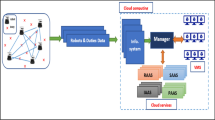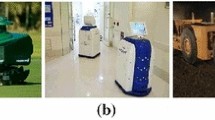Abstract
One of the possible approaches to the construction of control systems for groups of mobile robots using distributed cloud technologies is considered, for which a scheme of access to information resources and a mechanism for distributing resources of a cloud computing system with linear decomposition are developed: The solution to the problem is divided into a series of smaller, simpler, subtasks in a hierarchical tree based on the linear distribution method. The specifics of the workspace model are shown, the goals of the functioning of robots are formalized, and the optimal energy evolutionary algorithm for solving the problem of distributing tasks in the team is proposed taking into account the initial and current levels of battery power, the energy consumption of each robot and the energy needed to perform individual tasks. Parameters for evaluating the effectiveness of the obtained solutions are determined, and genetic algorithms are synthesized, for which a coding form of the solution in the form of a chromosome is proposed and specific fitness functions are compiled. An algorithm has been developed for calculating the fitness function, implemented taking into account the specifics of its work in the cloud. Experimental results were obtained when checking the operability of the algorithms on the available onboard computing means of mobile robots, and the effectiveness of using distributed computing resources of a group of robots was estimated when implementing cloud services on their basis.
Access this chapter
Tax calculation will be finalised at checkout
Purchases are for personal use only
Similar content being viewed by others
References
Tuncer, A., Yildirim, M.: Dynamic path planning of mobile robots with improved genetic algorithm. Comput Electr Eng 38, 1564–1572 (2012)
Xiao, J., et al.: A hybrid membrane evolutionary algorithm for solving constrained optimization problems. Optik 125(2), 897–902 (2014)
Darintsev, O.V., Migranov, A.B.: Synthesize the strucrure of cloud computing system to control of mobile robots group. Proc. Mavlyutov Inst. Mech. Ufa Centre Russ. Acad. Sci. 11(1), 72–80 (2016)
Zakiev, A., Esoy, T., Magid, E.: Swarm robotics: remarks on terminology and classification. In: International Conference on Interactive Collaborative Robotics, pp. 291–300 (2018)
Olfati-Saber, R.: Flocking for multi-agent dynamic systems: algorithms and theory. Technical Report CIT (California Institute of Technology) CDS (Control and Dynamical Systems), pp. 401–420 (2006)
Schwager, M.: A gradient optimization approach to adaptive multi-robot control. Massachusetts Institute of Technology, Cambridge (2009)
McLurkin, J.: Analysis and implementation of distributed algorithms for multi-robot systems. Doctoral dissertation, Massachusetts Institute of Technology, Department of Electrical Engineering and Computer Science (2008)
Ahterov, A.V., Kiril’chenko, A.A., Pavlovsky, V.E., Rogozin, K.V.: Ways of controlling the distributed mobile system in the conditions of uncertainty. KIAM Preprint 67, 1–33 (2012)
Zhu, H.: Control of the movement of a group of mobile robots in a system of the type “convoy”. Dissertation for the Degree of Candidate of Technical Sciences, Moscow (2018)
Guy, S.J. et al.: Clearpath: highly parallel collision avoidance for multi-agent simulation. In: Proceedings of the 2009 ACM SIGGRAPH/Eurographics Symposium on Computer Animation, pp. 177–187 (2009)
Nazarova, A.V.: Methods and algorithms for multi-agent control of a robotic system. Bull. Bauman Moscow State Tech. Univ. 6, 93–105 (2012)
Kalyaev, I., Kapustjan, S., Gajduk, R.: Self-organizing distributed control systems of intellectual robot groups constructed on the basis of network model. Large-Scale Syst. Control 30(1), 605–639 (2010)
Kruglikov, S.V., Kruglikov, A.S.: An a priori planning of joint motions for USV as a problem of guaranteed control/estimation. Appl. Mech. Mater. 494, 1110–1113 (2014)
Darintsev, O.V.: The use of advanced and virtual reality technologies in the implementation of algorithms for managing a team of robots. Piece Intell. 3, 479–487 (2013)
Renzaglia, A., Martinelli, A.: Potential field based approach for coordinate exploration with a multi-robot team. In: 2010 IEEE Safety Security and Rescue Robotics, pp. 1–6. IEEE (2010)
Ivić, S., Crnković, B., Mezić, I.: Ergodicity-based cooperative multiagent area coverage via a potential field. IEEE Trans. Cybern. 47(8), 1983–1993 (2016)
Renzaglia, A., Doitsidis, L., Martinelli, A., Kosmatopoulos, E.B.: Cognitive-based adaptive control for cooperative multi-robot coverage. In: 2010 IEEE/RSJ International Conference on Intelligent Robots and Systems, pp. 3314–3320. IEEE (2010)
Janglova, D.: Neural networks in mobile robot motion. Adv. Robot. 1(1), 15–22 (2004)
Shah, H.N.M., et al.: Design and develop an autonomous UAV airship for indoor surveillance and monitoring applications. Int. J. Inform. Visual. (JOIV) 2(1), 1–7 (2018)
Zhang, L., Min, H., Wei, H., Huang, H.: Global path planning for mobile robot based on A* algorithm and genetic algorithm. In: 2012 IEEE International Conference on Robotics and Biomimetics (ROBIO), pp. 1795–1799. IEEE (2012)
Darintsev, O.V., Migranov, A.B.: Distributed control system for group of mobile robots. Vestnik USATU 21(2–76), 88–94 (2017)
Darintsev, O.V., Migranov, A.B.: Task distribution module for a team of robots based on genetic algorithms: synthesis methodology and testing. In: 2019 XXI International Conference Complex Systems: Control and Modeling Problems (CSCMP), pp. 296–300 (2019)
Acknowledgements
This research is supported by the Program of the Presidium of the Russian Academy of Sciences and within the framework of state assignment No. 0246-2018-007.
Author information
Authors and Affiliations
Corresponding author
Editor information
Editors and Affiliations
Rights and permissions
Copyright information
© 2021 The Editor(s) (if applicable) and The Author(s), under exclusive license to Springer Nature Singapore Pte Ltd.
About this paper
Cite this paper
Migranov, A. (2021). Cloud-Based Task Distribution System Infrastructure for Group of Mobile Robots. In: Ronzhin, A., Shishlakov, V. (eds) Proceedings of 15th International Conference on Electromechanics and Robotics "Zavalishin's Readings". Smart Innovation, Systems and Technologies, vol 187. Springer, Singapore. https://doi.org/10.1007/978-981-15-5580-0_33
Download citation
DOI: https://doi.org/10.1007/978-981-15-5580-0_33
Published:
Publisher Name: Springer, Singapore
Print ISBN: 978-981-15-5579-4
Online ISBN: 978-981-15-5580-0
eBook Packages: Intelligent Technologies and RoboticsIntelligent Technologies and Robotics (R0)




